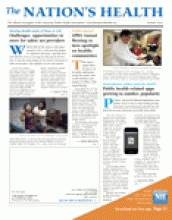From football in the fall to swim team in the summer — and everything in between — more kids are participating in sports than ever before. More than 38 million boys and girls ages 5 to 18 take part in some form of organized athletics each year in the United States, according to the U.S. Centers for Disease Control and Prevention.
“There are a lot of good things that can come out of sports,” says Joel Brenner, MD, MPH, director of sports medicine and adolescent medicine at Children’s Hospital of the King’s Daughters in Norfolk, Va.
“It’s important for everyone to be doing something, whether it’s playing football, soccer, doing karate, riding bikes or cheerleading — something they enjoy. Even if it’s other things that might be less strenuous from a cardiovascular standpoint, like golf — we want to make sure that they are getting off the couch,” says Brenner, who also serves as chair of the American Academy of Pediatrics’ Council on Sports Medicine and Fitness.
While exercise is important for your child’s health and overall development, sports-related injuries are common. According to Safe Kids USA, sports injuries send about 3.5 million children ages 14 and younger to doctors each year.
Kids’ sports injuries can range from scrapes and bruises to serious brain and spinal cord injuries. According to the National Institutes of Health, some of the common types of sports-related injuries in children are sprains and strains, bone injuries, repetitive motion injuries and heat-related stress. Nearly 40 percent of all sports-related injuries treated in hospital emergency departments are among kids ages 5 to 14, but the rate and severity of sports-related injuries increases with each birthday.
“One of the unique problems with a child or adolescent is that their bones are still growing,” Brenner says. “Their growth plates are still open, so they are at risk for growth-plate injuries, which can occur more commonly when they go through their growth spurt.”
Thankfully, a few simple precautions taken before the game clock starts or the whistle blows can help parents and caregivers protect their young athletes from injuries — and keep them in the game.
“Many injuries in youth sports are entirely preventable,” says Lindsay Hansen, MPH, recreational safety program manager for Safe Kids USA. “There are many things you can educate yourself on and prepare yourself for to avoid such instances.”

Art courtesy iStockphoto: baseball players, Catherine Yeuley
Watch out for heat, head injuries
Heat-related illnesses are dangerous — and can be deadly.
Kids who play rigorous sports in the heat should consume plenty of water, starting before the activity begins and continuing frequently throughout play. Also, be aware of the signs of heat-related problems, including nausea, dizziness, weakness, headache, confusion, dilated pupils, fainting, heavy perspiration, weak pulse, pale and moist skin or hot, dry skin.
“Coaches should establish mandatory water breaks during practices and games,” Hansen says.
Also, to reduce the risk of overuse injuries, make sure your young athlete takes rest periods during practice and games. Children who are injured need to be seen by a pediatrician right away.
Brain injury tops the list of the leading causes of sports-related death in children. Among the 38 million U.S children who participate in sports each year in the United States, concussions are one of the most commonly reported injuries.
“As a parent or coach, there is no excuse for not knowing the signs or symptoms of a concussion,” Hansen says. “Reading up on and being aware of the signs and symptoms of a concussion could potentially save your child’s life or prevent them from having a serious mental dysfunction later in life.”
Heed the red flags: If a child appears confused, dizzy, sleepy, has a headache or is vomiting, she or he may have suffered a concussion and should be removed from play and taken to the emergency room.
Protective equipment is key
Whatever the sport, make sure your child has access to the appropriate gear, such as pads, helmets, mouthpieces, face guards and eyewear, and that the coach is enforcing the proper use of equipment.
Injuries happen when kids don't wear or use the protective equipment, or use it inappropriately. Talk with your child’s coach to determine what gear is needed and make sure your child is wearing the gear during practice as well as during play.
- Copyright The Nation’s Health, American Public Health Association









